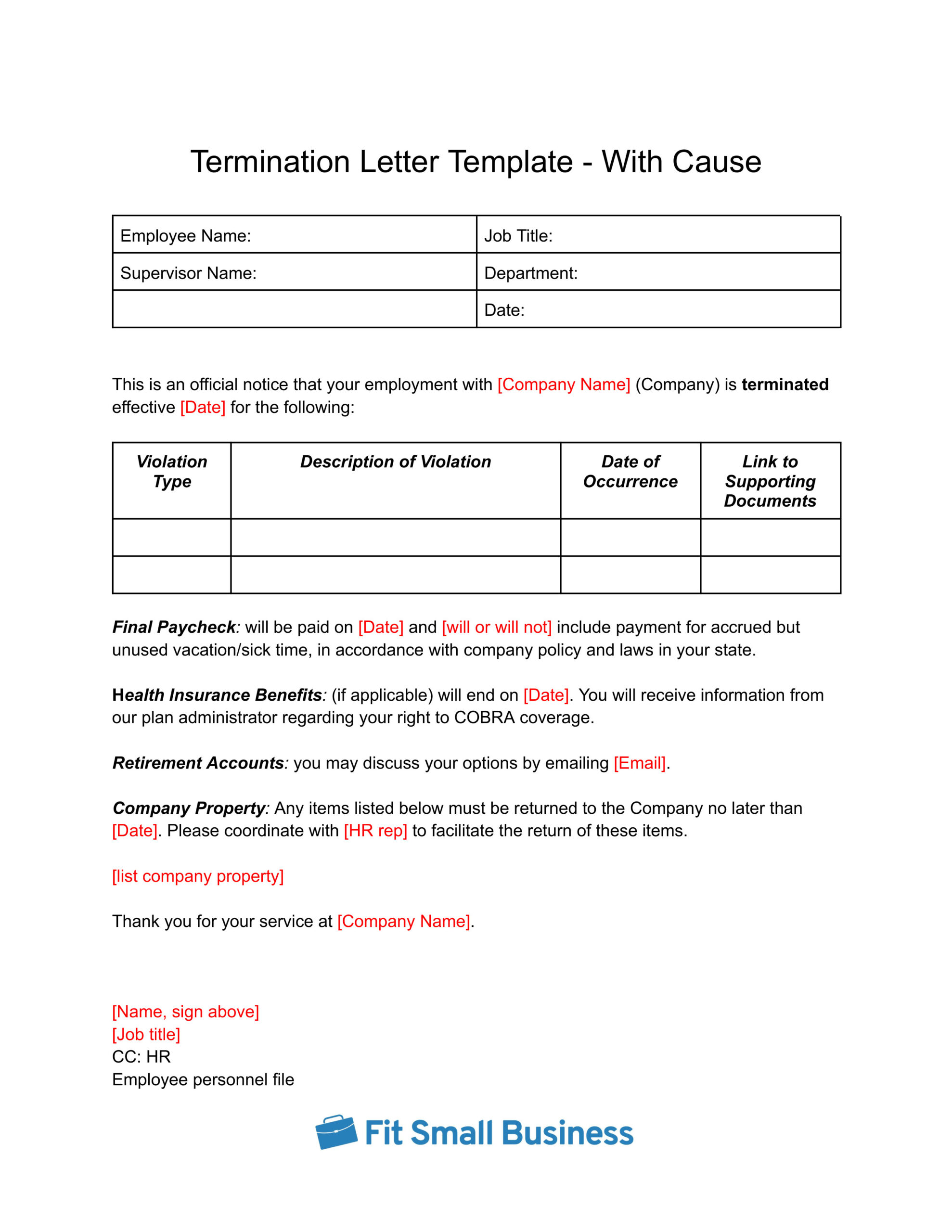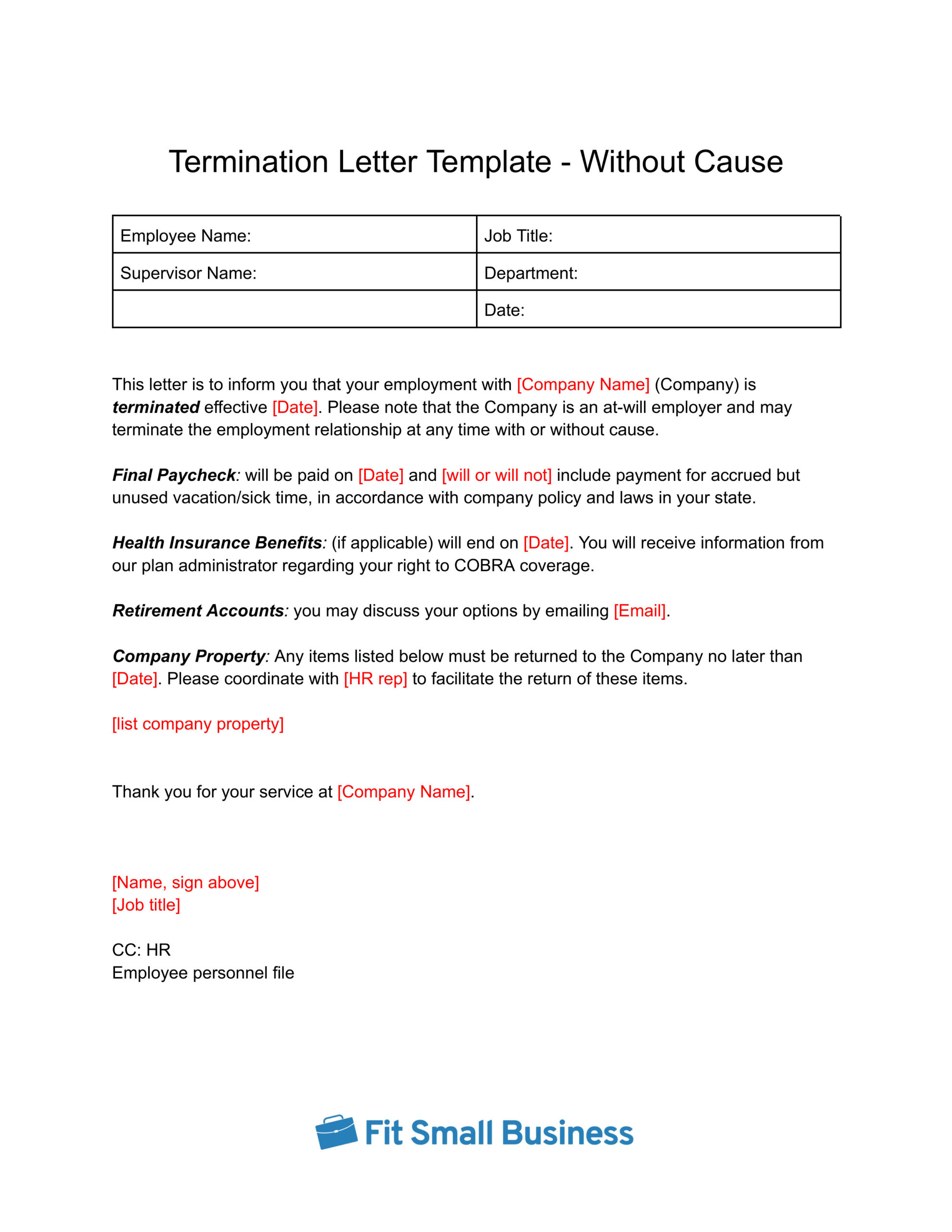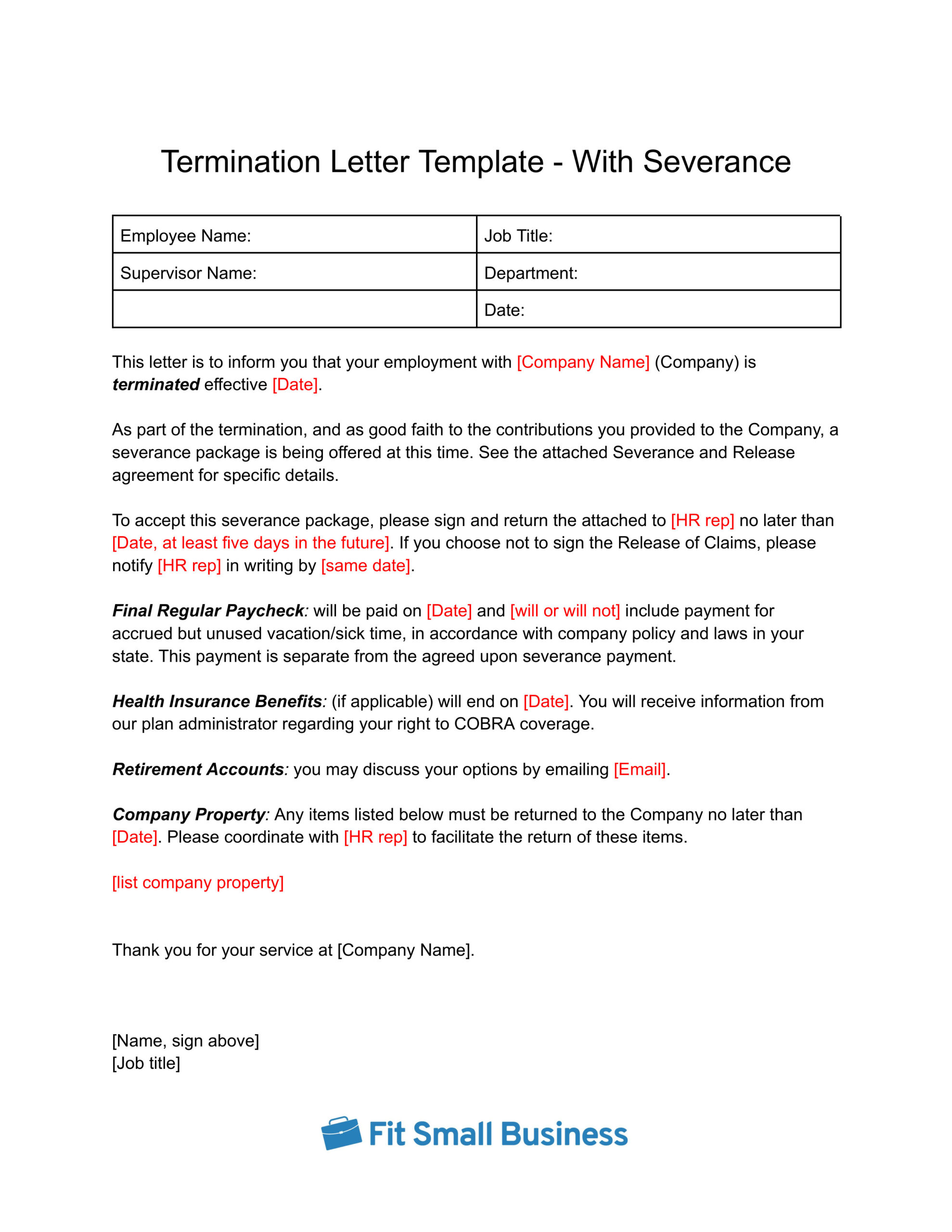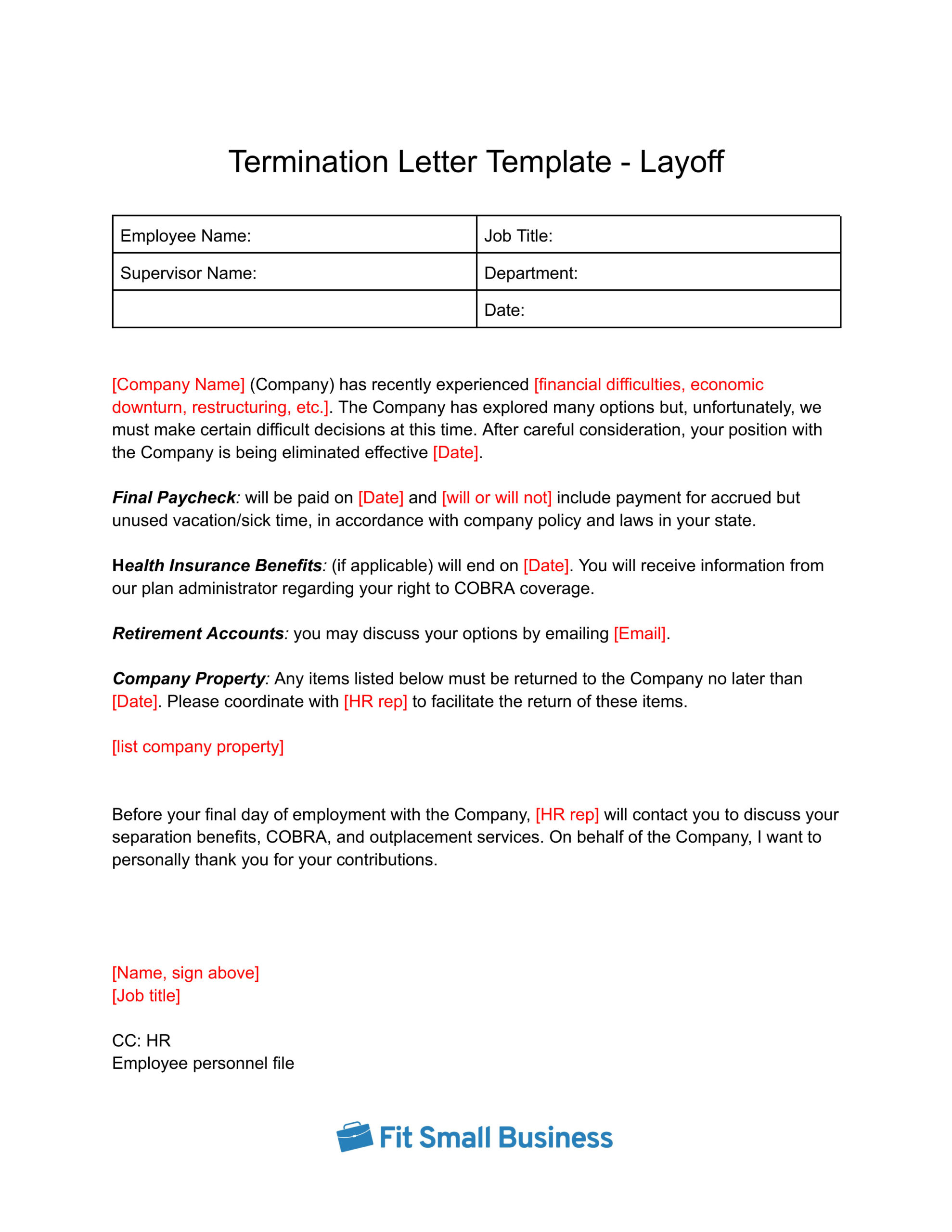A termination letter is a formal document that notifies an employee of a company’s decision to terminate their employment and/or eliminate their position. It is also used as an official business record containing the details of the termination and generally includes the date and reason for the termination, as well as information on the final paycheck and benefits continuation, severance (if applicable), and the return of company property.
We have provided four free termination letter templates for you to use (with cause, without cause, with severance, and layoff). Each one is customizable to your specific needs and termination situation. Click on the links above where you can download the template you need.
Types of Termination Letters
There are four types of termination letters—termination with cause, termination without cause, termination with severance, and layoff termination. The type provided to an exiting employee is determined by why they are being exited. Although supplying the letter is often self-explanatory for the employee to understand they are being exited, it’s always best to sit them down and have a conversation so that they fully understand everything it entails.
Termination With Cause
Some incidents and behaviors warrant immediate termination for cause. Egregious violations of company policy, workplace violence, and illegal behavior all qualify. Immediately terminate the individual for these reasons, and then write a termination letter. This is one instance where you may conduct the in-person termination and then send the employee a letter later in the day. If you are not delivering it in person, it is recommended to send the termination letter by certified mail to confirm receipt.
An employee may also be terminated for poor performance. While this can happen after a single incident, it’s usually the result of progressive discipline where the employee failed to improve. When you follow your employee management process, you can be confident that your documentation is in order, giving you a legitimate business reason for the termination and support for your termination letter.
Termination Without Cause
If an employee has underperformed or engaged in inappropriate workplace behavior, you may choose to terminate them for a cause—but you may also choose to terminate without cause. Most companies are at-will employers, meaning that an employer can terminate an employee with or without cause at any time.
In the case of a termination without cause, keep your letter simple and professional. Let the employee know that their employment has ended and provide the date of termination along with any information about final pay. You will also want to include language that requires the employee to return any company property.
Termination With Severance
If you choose to terminate an employee, with or without cause, you may decide to provide a severance package. This means providing additional wages to an employee, either in a lump sum or over time.
Be sure to include verbiage about the severance package in your employment termination letter. While you should keep it brief, outline the highlights of the severance package and let the employee know the date they must return the signed severance agreement to HR.
Your severance package should also include a release of claims, which is a legal document that states that the employee, in return for severance pay, releases your company from any claims, as well as waives their right to sue post-departure.
Layoff Termination
A layoff occurs when a company is downsizing, restructuring, or hitting financial trouble. While an involuntary termination isn’t directly due to an employee’s inability to perform their job, most employees will take a layoff personally and figure they did something wrong.
It’s crucial to express compassion—but not remorse—in a layoff letter. Don’t apologize, and don’t say you wish it had been someone else. Keep it professional and express your appreciation for their contribution to the company.
What to Include in a Termination Letter
In addition to notifying an employee that their job with the company has ended, a termination of employment letter puts closure on the situation and gives you the chance to lay out additional information, some of which may be required by law. It’s a professional move that can help your company keep a good reputation and maintain compliance.
Be sure to check with your employment lawyer to ensure you comply with all local labor laws and do not say anything that could get your company into trouble. It is important to avoid getting into too much detail about why the employee was terminated—keep both the termination discussion and employment termination letter brief.
Include the following information in your termination letter:
Termination Date
The termination date is important because there should be no ambiguity about the employee’s last day, which could be the same day you speak with the employee and give them the termination letter. It also specifies the last day on which the employee will be paid.
Termination Date Example Wording: This letter is to inform you that your employment with [Company Name] is terminated effective as of [Date].
Reason for Termination
If you are providing a reason, be sure to state it clearly but briefly. If, for instance, you are terminating an employee because of workplace violence, you can cite the employee’s inappropriate behavior as grounds for immediate termination. It is also advised that you provide supporting documents.
Termination Example Wording: This letter is to inform you that your employment with [Company Name] (Company) is terminated effective as of [Date]. The reason for this termination is: [provide information about the incident or progressive discipline leading to termination]
Legal Information
Let the employee know their final paycheck date and provide them with details about benefits continuation and Consolidated Omnibus Reconciliation Act (COBRA) coverage. Include information about when their current benefits will end and provide contact information for any retirement benefits. If you’re offering a severance package, this will be the place to provide details.
Legal Information Example Wording: Your final paycheck from the Company will be paid on [Date] and [will or will not] include payment for accrued but unused vacation/sick time. Your health insurance benefits, if applicable, will continue through [Date]. You will receive information from our plan administrator regarding your right to COBRA coverage. If you have retirement accounts with the Company, you may discuss your options by emailing [Email].
Return of Company Property
If your business provides property to help employees complete their work outside of the office, you need to clearly state in your letter of termination of employment that such property should be returned in a reasonable timeframe. Whatever company property the employee has, list each item and detail how the employee should return those items. This may include a work laptop, mobile phone, office keys, company credit cards, and more.
Return of Company Example Wording: Company records indicate that you have the following Company property in your possession:
[list items]
These items must be returned to the Company no later than [Date]. Please coordinate with [HR rep] to facilitate the return of these items.
States That Require Formal Termination Letters
Businesses are not required to provide termination letters to employees under the Fair Labor Standards Act (FLSA), but it is good practice. Besides that, certain states do require a formal termination letter, with some requiring additional information to be included in the notice.
The following states have formal termination letter requirements and may require you to include additional information in your notice:
- Alabama
- Arkansas
- California
- Colorado
- Connecticut
- Georgia
- Illinois
- Iowa
- New York
- South Carolina
- Tennessee
Frequently Asked Questions (FAQs)
Companies often choose to forego putting a termination reason in writing in an attempt to avoid a lawsuit. However, if you have a legitimate business reason for terminating an employee and the documentation to back it up, it is recommended to include this in the termination letter.
This depends on the type of termination an employee receives. Being fired means that your employment with a company is terminated immediately without any additional compensation (other than that required by law). Being let go with a severance package is being terminated with compensation. It is an extension of wages after the employee is terminated. Additionally, a layoff, while also a termination, may include a severance.
Do not allude to, discuss, or write that an employee is being terminated for a discriminatory reason. While at-will employment gives you the right to terminate an employee at any time and for any reason, it is only allowed provided that the real reason for termination is non-discriminatory.
Bottom Line
Terminating an employee is not easy, but every business has to do it from time to time. Maintaining professionalism and focusing on your business can make the termination letter seem sterile, but that’s for the good of your company. As a result, you show the departing employee you have no hard feelings and maintain your company’s reputation.
If you need help terminating an employee and crafting a termination letter, consider using Bambee. It is HR software that helps your company stay compliant, assists with onboarding and terminations, and offers payroll services. You can try it for free for 30 days.







